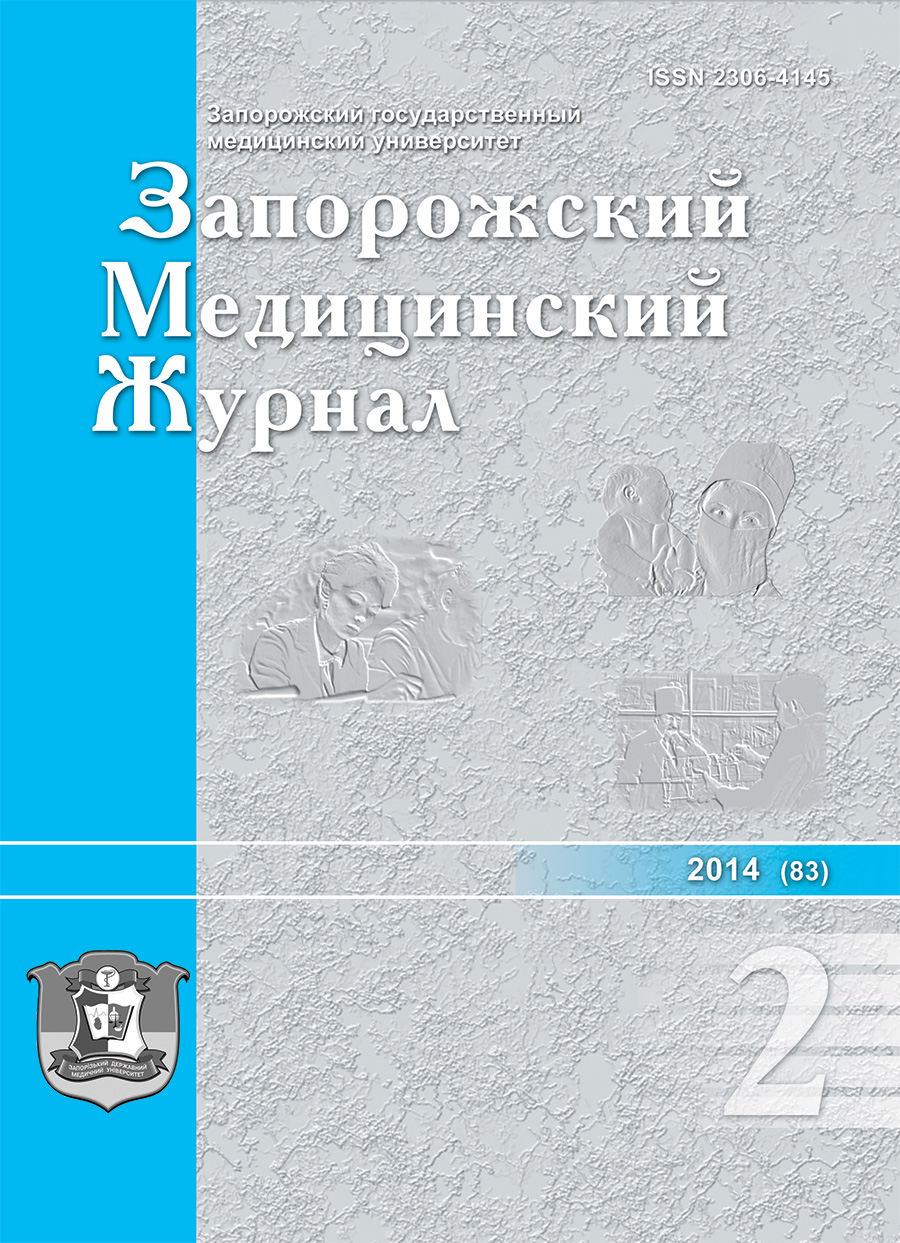Structural myocardial changes in chronic heart failure of II functional class based on overweight and abdominal obesity
DOI:
https://doi.org/10.14739/2310-1210.2014.2.25234Keywords:
сhronic heart failure, structural myocardial changes, overweight, obesityAbstract
Abstract. 153 patients with CHF of II functional class, with normal weight, overweight and abdominal obesity I-III degrees Examined. Studied structural myocardial changes at CHF depending on the degree of excess weight. Structural changes of the heart, the extent and type of myocardial hypertrophy of left ventricle depending on the availability of overweight and obesity were revealed.
Actuality. Chronic heart failure (CHF) is characterized by a high mortality rate and frequency of hospitalization of patients, a significant decline in their quality of life and significant financial burden. CHF is a medical and social problem that a certain dominant in the near future all over the world, because the average life expectancy of patients with the diagnosis ranges from 1,7 to 7 years and the long-term observation is evidence of the increased risk of death, that 5 year more than four times the initial value. The main etiological factors of occurrence, progression and adverse exit of CHF are age, coronary heart disease (CHD), arterial hypertension, valvular heart disease, diabetes and obesity. In general, structural changes of heart in obesity can be divided into the following main components: left ventricle hypertrophy, changes in the structural composition of cardiac tissue, heart obesity, change of the sizes of the right ventricle and left atrium (PL), valvular heart disease.
Research objective: to establish the structural changes of CHF of II functional class depending on the availability of overweight and abdominal type of obesity various degrees.
Material and methods: 153 patients with CHF of II functional class were examined. Etiological factors of development CHF were hypertensive disease, chronic forms of CAD and the combination of these pathologies. The diagnosis of CHF installed according to WHO criteria, the European society of cardiology and the Association of cardiologists of Ukraine, and classified according to functional classification of New York Heart Association (NYHA). Overweight and abdominal obesity diagnosed based on the WHO criteria, the degree and abdominal (visceral) type of obesity gradualist common metric indices. Criteria for inclusion in the study: the patient's consent to participate in the study, CHF of II functional class (NYHA) resulting from hypertensive disease, chronic forms of CAD and the combination of these pathologies in patients with normal weight, overweight and abdominal obesity of I-III degree. According to the aim of the research four groups of patients with CHF of II functional class (NYHA) were formed. The group included 23 patients with normal body weight, II group formed of 36 patients with overweight, in the III group included 48 subjects with obesity of the I degree. IV group consisted of 46 patients with obesity II-III degree, due to the lack of significant differences in indicators studied. The control group consisted of 23 patients with normal body weight and without CHF. All patients underwent echocardiography using ultrasonic scanner "SONOACE 8000 SE. Used M – and B-scan modes.
Conclusions:
1. With increasing body mass in chronic heart failure of II functional class marked increase in the degree of dilatation of all cavities of the heart, is maximal in groups with obesity.
2. Among patients with chronic heart failure of II functional class, the increase in the degree of myocardial left ventricular hypertrophy with weight gain, and the absolute dominance of concentric type of the left ventricle hypertrophy were detected.
References
Voronkov L.G. Patient with CHF in Ukraine: analyze all population, were examined at first national slice investigation UNIVERSE. Serdechnaia nedostatochnost 2012; 1: 8-13.
Manoilenko T.S., Reven`ko I.L., Handzyuk V.A. Kornatskyi Yu.V. (2011) Racionalni osoblyvosti rivnia zdorov`ia narodu Ukrainy (analityo-statystychnyi posibnyk) [Rational features of health level at people of Ukraine (analytical-statistic manual)]. Nacionalnyi naukovyi centr «Instytut kardiologii imeni akad. M.D.Strazheska»: 211 [In Ukrainian].
David S. Frankel, Ramachandran S. Vasan, Ralph D`Agostino. Resistin, Adiponectin, and Risk of Heart Failure. The Framingham Offspring study. J. Am. Coll. Cardiol. 2009: 53: 754-762.
Abel E.D., Litwin S.E., Sweeney G. Cardiac Remodelling in Obesity. Physiol. Rev. 2008; 8: 389 – 419.
Paul Poirier, Thomas D. Giles, George A. Bray. Obesity and Cardiovascular Disease Pathophysiology, Evaluation, and Effect of Weight Loss. Arterioscler. Thromb. Vasc. Biol. 2006: 26; 968-976.
Christophe Tribouilloy, Dan Rusinaru, Haifa Mahjoub. Prognosis of heart failure with preserved ejection fraction: a 5 year prospective population-based study. European Heart Journal. 2008: 29; 339–347.
Avelar E., Cloward T., Walker J.M., Farney RJ. Left ventricular hypertrophy in severe obesity: interactions among blood pressure, nocturnal hypoxemia, body mass. Hypertension 2007: 49; 34–39.
Iacobellis G., Leonetti F. Epicardial adipose tissue and insulin resistance in obese subjects. J. Clin. Endocrinol. Metab. 2005: 90; 6300–6302.
Wang T.J., Parise H., Levy D., D’Agostino R.B. Sr, Wolf .P.A. Obesity and the risk of new-onset atrial fibrillation. J. Am. Med. Assoc. 2004: 292; 2471–2477.
Downloads
How to Cite
Issue
Section
License
Authors who publish with this journal agree to the following terms:
Authors retain copyright and grant the journal right of first publication with the work simultaneously licensed under a Creative Commons Attribution License that allows others to share the work with an acknowledgement of the work's authorship and initial publication in this journal. 
Authors are able to enter into separate, additional contractual arrangements for the non-exclusive distribution of the journal's published version of the work (e.g., post it to an institutional repository or publish it in a book), with an acknowledgement of its initial publication in this journal.
Authors are permitted and encouraged to post their work online (e.g., in institutional repositories or on their website) prior to and during the submission process, as it can lead to productive exchanges, as well as earlier and greater citation of published work (See The Effect of Open Access)

